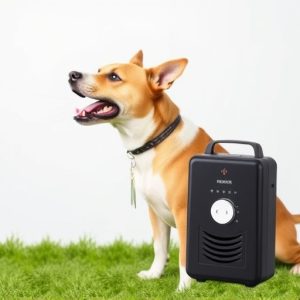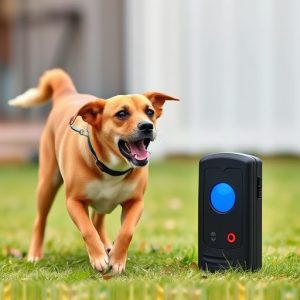Ultrasonic Dog Deterrents: Science-Backed Solutions for Aggressive Pets
Aggressive pet behavior can be mitigated with the Effective Distance Electronic Dog Deterrent, a hum…….
Aggressive pet behavior can be mitigated with the Effective Distance Electronic Dog Deterrent, a humane solution using ultrasonic sounds or vibrations to create a safe space up to 10 feet. These devices, like ultrasonic bark deterrents, emit inaudible waves to startle dogs without harm, but their effectiveness depends on device specifications and environmental factors. For best results, choose models with adjustable frequency settings and sensitivity control, and always pair with consistent training and positive reinforcement for long-term behavior modification.
“Unleash a peaceful environment with an ultrasonic dog deterrent—a game-changer for managing aggressive pets. This comprehensive guide explores the science and effectiveness of these electronic deterrents, addressing common challenges in pet behavior. From understanding the causes of aggression to choosing the right device, we cover it all. Learn about safe training practices and discover how these devices offer a quiet, non-invasive solution within an effective distance of up to 30 feet. By the end, you’ll be equipped to make an informed decision for your pet’s well-being.”
- Understanding Aggressive Pet Behavior: Causes and Challenges
- The Science Behind Ultrasonic Dog Deterrents
- How Effective Is an Electronic Dog Deterrent?
- Choosing the Right Device: Features to Consider
- Training and Safety Guidelines for Using Ultrasonic Detersrants
Understanding Aggressive Pet Behavior: Causes and Challenges
Aggressive pet behavior can stem from various causes, making it a complex challenge for pet owners and veterinarians alike. Factors such as fear, territorial instincts, past trauma, or even genetic predisposition can trigger aggressive responses in dogs. Understanding these underlying reasons is crucial when implementing solutions like an electronic dog deterrent.
One of the key advantages of an Effective Distance Electronic Dog Deterrent is its ability to address specific triggers without causing harm. These devices emit ultrasonic sounds or vibrations that are unpleasant for dogs, encouraging them to alter their behavior without physical punishment. By setting the device at an appropriate range—often up to 10 feet (3 meters) or more—pet owners can create a safe space where aggressive tendencies are deterred, promoting better behavior and a calmer environment for both the pet and the owner.
The Science Behind Ultrasonic Dog Deterrents
Ultrasonic dog deterrents operate on a simple yet effective principle: emitting high-frequency sound waves that are inaudible to humans but disruptive to dogs. These devices use an electronic transducer to generate ultrasonic sounds, typically ranging from 25 to 64 kHz. This frequency range is above the human hearing threshold but within the sensitive auditory range of dogs. When a dog approaches the deterrent, it perceives the sound as an irritant, causing them to alter their behavior and avoid the area.
The ‘effective distance’ of these deterrents refers to the radius within which the ultrasonic signals can be detected by the dog. This distance varies depending on several factors, including the power output of the device, environmental conditions, and the size and sensitivity of the dog’s ears. Most electronic dog deterrents are designed to cover a specific area, typically measured in square feet or meters, ensuring that the sound waves reach and deter aggressive dogs from entering that space.
How Effective Is an Electronic Dog Deterrent?
The effectiveness of an electronic dog deterrent, like those that use ultrasonic technology, depends on several factors, including the device’s specifications and how it’s used. These deterrents emit high-frequency sound waves that are typically inaudible to humans but can startle or annoy dogs, encouraging them to stay away from certain areas. The claimed effective distance varies across models, with some manufacturers stating up to 15 feet (4.5 meters), but real-world performance can be influenced by environmental conditions like temperature, wind, and obstructions.
In ideal scenarios, electronic deterrents can be highly effective in modifying a dog’s behavior, especially for issues like barking or aggression triggered by specific zones. However, it’s crucial to note that these devices don’t address the root cause of aggressive behaviors; they merely provide a temporary solution. Consistent training and positive reinforcement remain essential components of long-term behavior modification for aggressive pets.
Choosing the Right Device: Features to Consider
When selecting an ultrasonic dog deterrent, understanding its effective distance and features is key to ensuring it suits your needs. These devices emit high-frequency sound waves that are generally harmless to dogs, but are unpleasant for them, deterring aggressive behavior like barking or biting. Look for models with adjustable frequency settings to accommodate different pet sizes and sensitivities. The ability to control the device’s sensitivity level is also important; this feature ensures it responds only to your dog’s barks while ignoring other environmental noises.
Additionally, consider devices with a range of around 10-15 feet (3-4.5 meters), which is typically sufficient for indoors or confined outdoor spaces. For larger areas, some models offer extended ranges up to 50 feet (15.24 meters). Waterproof designs are advantageous for outdoor use, while compact and portable options provide flexibility in placement. Always check customer reviews to ensure the device’s effectiveness and reliability before making a purchase.
Training and Safety Guidelines for Using Ultrasonic Detersrants
When using an ultrasonic dog deterrent, proper training is key for both pet and owner. Before introducing the device, ensure your pet is comfortable with their environment and isn’t easily startled. Start by acclimatizing them to the sound of the deterrent at a low volume, gradually increasing as they become accustomed. This process helps prevent fear or aggression towards the device. Regular positive reinforcement training during and after exposure can reinforce good behavior.
Safety guidelines must be followed rigorously when using an electronic dog deterrent. Always keep the device out of reach of children and other pets to avoid accidental activation. The effective distance varies by model, but generally, these devices work best within 10-15 feet. Ensure the sensor is positioned correctly, aimed at your pet’s line of sight, to trigger the ultrasonic sound consistently. Regular maintenance and battery checks are essential to keep the deterrent functioning optimally. Remember, consistent use and patience during training are vital for successful results.
Ultrasonic dog deterrents offer a non-violent, effective solution for managing aggressive pet behavior. By understanding the science behind these devices and following proper training guidelines, pet owners can harness the power of sound to create a safe environment for both their pets and others. When choosing an electronic dog deterrent, consider factors like frequency range, effective distance, and user-friendly features. With diligent training and consistent use, ultrasonic deterrents can help transform aggressive behaviors into calm, well-behaved companions, ensuring peace of mind for pet owners everywhere.


